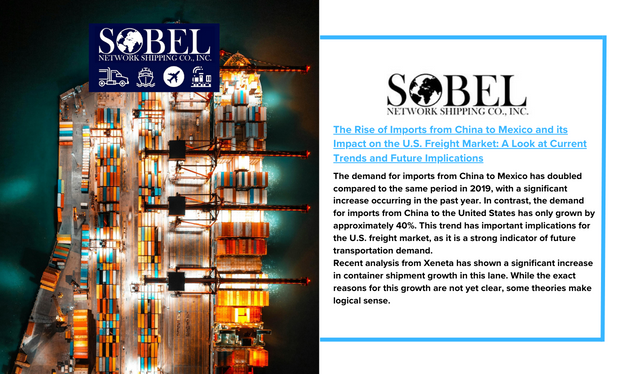The demand for imports from China to Mexico has doubled compared to the same period in 2019, with a significant increase occurring in the past year. In contrast, the demand for imports from China to the United States has only grown by approximately 40%. This trend has important implications for the U.S. freight market, as it is a strong indicator of future transportation demand.
Recent analysis from Xeneta has shown a significant increase in container shipment growth in this lane. While the exact reasons for this growth are not yet clear, some theories make logical sense. The concept of nearshoring, or moving production closer to the end consumer, has been gaining attention in recent years due to growing tensions between the U.S. and China. However, what is often overlooked is that China is highly dependent on the U.S. consumer market for its production. As a result, China may be actively seeking new solutions to diversify its production.
One possible solution is reflected in the increase in imports from China to Mexico. It is believed that China and its sourcing partners may be bypassing tariffs by bringing goods into Mexico before sending them across the border into the U.S. This essentially makes the goods “Mexican” imports and allows them to avoid tariffs. While this may be difficult for the U.S. to prove or enforce, it provides a significant advantage to the Chinese in terms of cost and competitiveness.
Another theory is that China is increasing its investments in Mexico’s manufacturing sector, anticipating that the U.S. will be more willing to engage in trade with its southern neighbor. If this theory holds true, it is likely that we will continue to see an increase in imports from China to Mexico, as well as further evolution of the North American supply chain.
It is worth noting that while the influx of imports from China to Mexico may be seen as a threat to the U.S. market, it is difficult to determine the exact impact at this point. This is partly due to the ongoing pandemic, which has created an unstable shipping environment. However, it is clear that the Southern border is becoming increasingly important for domestic transportation, and this trend is likely to continue in the future.
The Port of Los Angeles has seen a 40% increase in imports annually, while Long Beach has seen an 11% increase. Interestingly, the trend in import bookings from China to Mexico has mirrored the trend in Los Angeles import volumes over the past year. This suggests that the Southern border is becoming a key entry point for Chinese goods into the U.S.
Cities located on the border, such as Laredo, Texas and Tucson, Arizona, have experienced rapid growth in the past five years. Laredo has seen a 137% increase in tender volumes compared to March of 2019, while Tucson’s volumes have increased by a staggering 237%. Both of these cities are home to major border crossing points, further supporting the idea that the Southern border is becoming a crucial part of the North American supply chain.
In conclusion, it is clear that the Southern border is playing an increasingly important role in the U.S. freight market. Whether it is due to nearshoring, tariff bypasses, or other factors, the influx of imports from China to Mexico is a significant trend to watch. As the global trade landscape continues to evolve, it is likely that we will see further changes in the North American supply chain, with the Southern border playing a crucial role.


